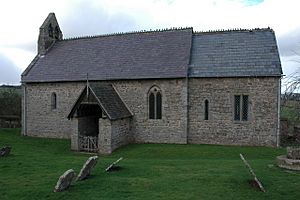St Mary's Church, Wormsley facts for kids
Quick facts for kids St Mary's Church, Wormsley |
|
|---|---|

St Mary's Church, Wormsley, from the south
|
|
| Lua error in Module:Location_map at line 420: attempt to index field 'wikibase' (a nil value). | |
| OS grid reference | SO 427 477 |
| Location | Wormsley, Herefordshire |
| Country | England |
| Denomination | Anglican |
| Website | Churches Conservation Trust |
| Architecture | |
| Functional status | Redundant |
| Heritage designation | Grade II* |
| Designated | 2 September 1966 |
| Architectural type | Church |
| Style | Norman, Gothic |
| Groundbreaking | 12th century |
| Specifications | |
| Materials | Sandstone, Welsh slate roofs with tiles |
St Mary's Church is a very old church in Wormsley, England. It's about 7.5 kilometers (4.7 miles) north-west of Hereford in Herefordshire. This church is special because it's a 'redundant' church. This means it's no longer used for regular church services. Instead, a group called the Churches Conservation Trust takes care of it. They help protect old churches like this one. St Mary's Church is also a Grade II* listed building. This means it's a very important historical building.
Contents
The Story of St Mary's Church
St Mary's Church has parts that are from the 12th century. That's over 800 years ago! These parts show a style called Norman architecture. People think an even older church might have been on this spot before.
The church was changed a few times over the years. Some updates happened in the 13th century. The part of the church called the chancel was probably rebuilt in the 19th century.
On March 1, 1972, the church was officially declared 'redundant'. This meant it was no longer needed for regular worship. Then, on May 21, 1974, the Churches Conservation Trust took over its care. They make sure this historic building is preserved for everyone to see.
What the Church Looks Like
St Mary's Church is built from sandstone rocks. It has a roof made of Welsh slate tiles. The church has a simple shape. It has a main area called the nave and a smaller section called the chancel. There's also a small porch on the south side.
At the west end of the nave, there's a bellcote. This is a small tower that holds two bells. It has two openings shaped like a three-leaf clover, which is called a trefoil. This bellcote is from the 13th century.
On the north side of the nave, there's an old doorway that is now blocked up. Next to it are two narrow, tall windows called lancet windows. On the south side, there are more lancet windows. The east window has three stepped lancet windows. The main south doorway is from the 12th century. It has a large stone above it called a lintel. Below the lintel is a carved stone panel called a tympanum, decorated with diamond shapes.
Inside the Church
The arch that separates the nave from the chancel is from the 13th century. The font, where baptisms take place, is very old too. It's from the 12th or 13th century. It has a round bowl on a round base.
The pulpit, where sermons are given, is made of oak wood. It dates back to the 17th century. The east window has beautiful stained glass. On the north wall, there are special brass plaques. These remember two local men who died in the First World War.
Exploring the Churchyard
The churchyard around St Mary's Church is also full of history. There's an old cross and four monuments that are also listed buildings. Only the stone steps and base of the churchyard cross remain. They are made of sandstone and might be from the 14th century.
You can also find a sandstone tomb from the late 1700s. It remembers two sisters from the Knight family. There are three other stone tombs made of limestone in a Neoclassical style. One of these, from 1824, belongs to Richard Payne Knight. He was a famous archaeologist, architect, and writer.
Near his tomb is the tomb of his brother, Thomas Andrew Knight, from 1838. Thomas was an expert at growing fruit. He even created new kinds of apples! There's another tomb for a different Thomas Andrew Knight from 1827. To the east of the church, there's also a war grave for a Royal Navy sailor who died in the Second World War.
See also

